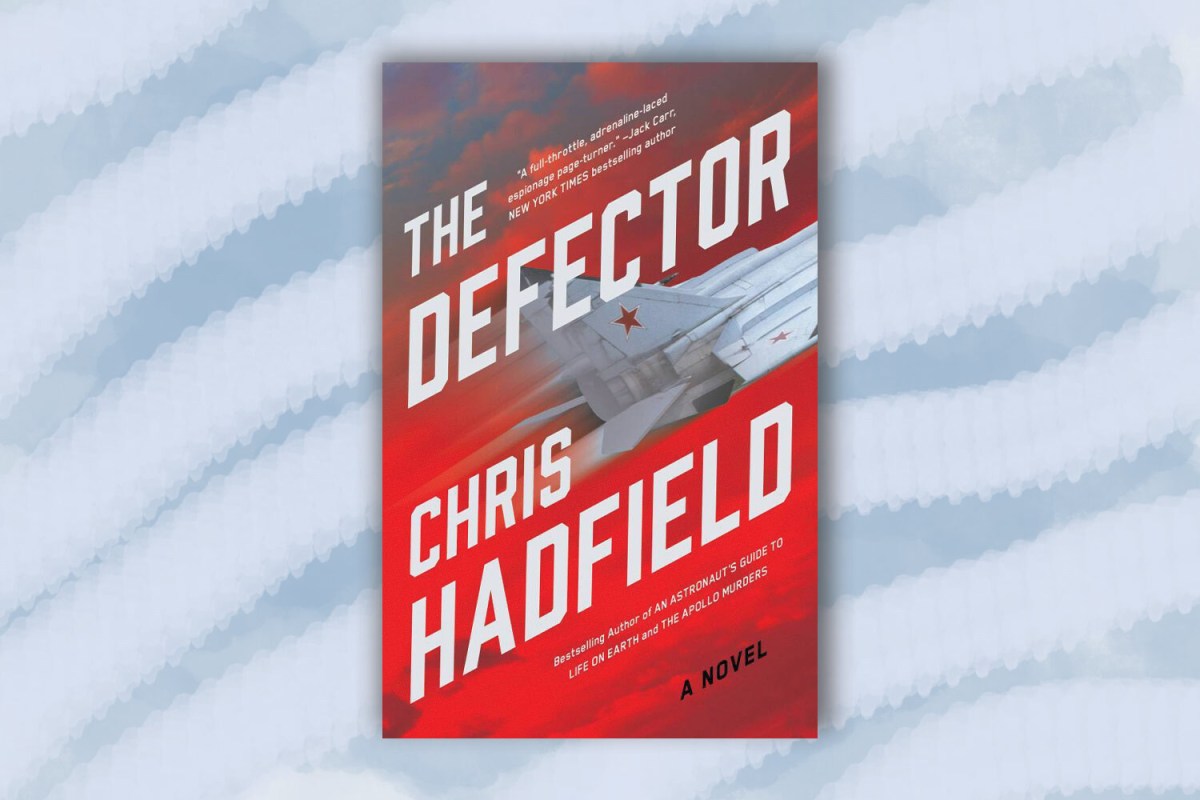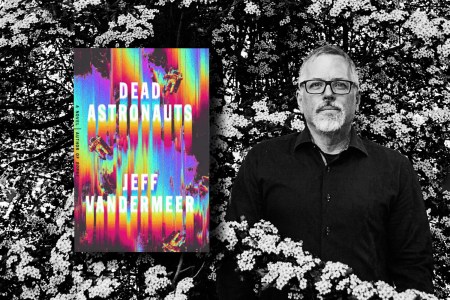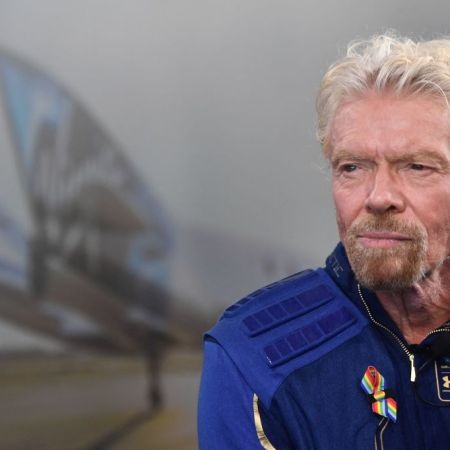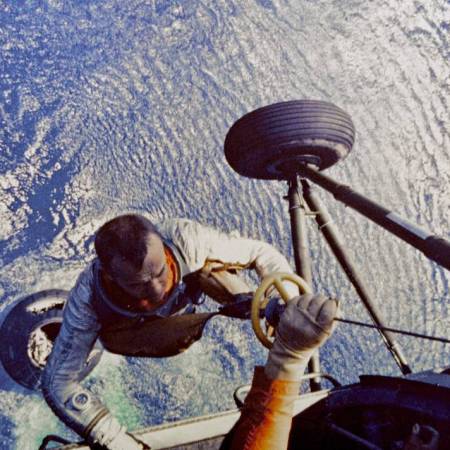You might know Chris Hadfield’s name from his time spent in space as an astronaut, which included a memorable rendition of “Space Oddity” performed on the International Space Station. These days, Hadfield is also an author, combining his wealth of knowledge about space travel and military hardware with his love of thrillers.
His latest book, The Defector, follows former test pilot Kaz Zemeckis, the same character who was at the center of his previous novel, The Apollo Murders. Here, Kaz’s expertise is required when a Soviet fighter pilot defects to the United States, his MiG-25 in tow. Hadfield weaves real-life events into his novel, including the Yom Kippur War and the Apollo-Soyuz program, though much of this novel’s appeal comes from Hadfield’s knowing evocation of what it’s like to fly a high-tech jet fighter in high-risk situations.
Hadfield spoke with InsideHook about the genesis of The Defector, the real-life historical events that inspired it and what UFO culture has to do with the book.
InsideHook: If I hadn’t already known that you have a background as a pilot, I probably would have guessed it because the level of detail in The Defector about some of the planes and what it’s like to fly them is amazing. Do you have direct experience piloting any of the planes that are described in the book?
Chris Hadfield: You know, it’s the type of book that I’ve always liked. I like knowing why, and I like to know how things work and I like the details when I’m reading something. I like learning stuff. I like getting insight from experts, so it’s the type of book that’s always appealed to me. I also like thriller fiction, I like escapism when I’m reading a book; I like to be transported somewhere else. And so it made sense to me when I started writing fiction with The Apollo Murders and now The Defector to write books in areas where I have deep and unusual experience.
I’ve flown about 100 different types of airplanes, everything from single person gliders where you’re towed up by another airplane or towed up by a winch, right through to the C-141 and the C-5 Galaxy and the 747, [which are] great big heavy transport airplanes. I’ve flown a bunch of different fighters — airplanes that have F as their designation — and I was a combat fighter pilot in the F-18.
During the Cold War, I was intercepting Soviet bombers that were practicing cruise missile launches on North America, with a fully armed F-18 out over the black waters of the North Atlantic. Some of those airplanes I’ve flown are in The Defector and also in The Apollo Murders, but I haven’t flown a MiG-25. I was never in a position or qualified to fly that, but I’ve flown a lot of similar things. And then I do what some people would probably consider a ridiculous amount of research — incredibly detailed research, based on everything that I know, to make sure that I’m getting it right.
For the MiG-25, because it’s central to The Defector, I found there was one in the United States at the Museum of the Air Force in Dayton, where the Wright brothers had their bicycle shop. I don’t know if you know the history of that airplane, but during the Gulf War, Iraq had some MiG-25s, and they didn’t want the Americans to get them, so they buried them under sand dunes — they actually buried them in the sand.
The American forces there found one and cleared the sand away and dragged it out of the sand and transported it, and it’s sitting in the refurbishment facility at the Museum of the Air Force. They gave me permission to spend a day with it. And so I was in the cockpit and crawling all around it and looking at the tires and up the exhaust and up the intakes and at the ejection seat and all the rest of it. For a pilot with my background, actually touching the airplane and standing on the top of it, that really gives you an inherent sense of it. So yeah, I didn’t fly the MiG-25, but hopefully I got it pretty close to right.
There’s a subplot about the UFO observer culture in the ’70s. How did you end up including that in the plot of the novel?
Obviously, UFOs are always fun and interesting and a lot of people believe very passionately in UFOs. The origin story of the whole UFO lore is based around Area 51. But the reason that enters into the story is, of course, that’s where the American Air Force and the CIA took all of their captured Soviet fighter planes to test and evaluate them and actually paint them with U.S. Air Force colors, and then use them as adversaries.
At the start of the Vietnam War, the American Air Force and the Navy were getting hammered by what seemed to be inferior airplanes like the MiG-21. But through some countries that weren’t completely allied with the Soviet Union, sometimes there was a defection or an opportunity when someone changed sides. And so they had MiG-17s, MiG-15s, MiG-21s, MiG-23s — they had all of those flying at Groom Lake, at Area 51, in the late ’60s and early ’70s.
So, as a fundamental plot piece of the book, that’s where they would take the MiG-25 because it’s completely away from all prying eyes. It’s a place that has all of the infrastructure to take an airplane right down to the bits, put it back together again and then fly it in the restricted airspace on the edge of the nuclear test range there. So all of that is true. To my knowledge, there’s never been a MiG-25 there, but there’ve been those other Sukhois and MiGs there. And so that made it all credible. But at the same time, especially in the ’70s, there were all those organizations that had UFO in their titles, and some of them still exist. And a lot of them were quite active in the Las Vegas area.
I’ve actually driven all the way around the nuclear test range and driven up the roads that lead up to Area 51 to Groom Lake, peering over the hills and getting a sense of what it was like for them back in the ’70s. It made an interesting reality that allowed another layer of plot possibility for me. And then to have that person actually be a low-level spy for the Soviet Union, for me, it was just a delightful little crossover.
There’s one sequence in The Defector where you explained how spy satellites worked in a pre-digital photography era, which I found especially fascinating.
A lot of that was pure research to make sure I got it all right. Fortunately, now some stuff’s been declassified, and we now know if you go into all of the old orbital tracking records, when they were launched, what orbits they were in and when they deorbited. All of that information is out there.
So right after the MiG-25 disappears and lands at Lod there in Tel Aviv, the reactions of the chief of the Soviet air force — who’s a real person — his reactions are, I think, 100% what would have happened. The actual satellites he’s referring to in the book are real — those were the satellites that were up at the start of the Yom Kippur War. I was trying to time it as to which one is going to fly over a place at a low enough altitude to get good resolution photography. And then, when is that film going to get deorbited so that then you can get access to it?
To me, that process is quite fascinating. You could say, “I had my appendix out.” Or you could go through the process of what actually happens when you get your appendix out. Both are interesting, but I think there’s a real learning fascination with the machinations of how things work. And I don’t think a lot of people know about it, especially now with digital photography where you can just beam pictures to the ground.
And from a personal point of view, on my first space flight, when I flew on Atlantis to go help build the Russian space station, Mir, we didn’t have digital photography. It was film back in the early and mid ’90s. And so on my first flight, the film was precious, and it was constantly getting exposed by the radiation environment of being above the atmosphere.
So yeah, constant film it’s going to be weeks or months until you see the picture you’ve taken. And you don’t know if you’ve got all your exposures right. It’s quite a different world now where you can instantaneously beam imagery. And because the book is set in the fall of 1973, I thought that would be both real as well as enlightening as to how people were gathering information about Area 51.
Jeff VanderMeer Searches for Where It All Went Wrong in New Book “Dead Astronauts”
The speculative-fiction writer isn’t afraid to take on the big questions: Climate change. Corporate influence. Trump.In the appendix of the book, you mention there was a real life case of a Soviet pilot defecting a couple of years after the events depicted in the book. Were there any elements of that that you repurposed for the novel?
Well, his name is Victor Balenko, and he was a MiG-25 pilot on the southeast coast of the Soviet Union in the ’70s. And so I think fundamentally, the fact that he defected with a MiG-25 in the mid ’70s, that’s just more credibility for this story. The allied forces had made it well known that there were huge rewards for anybody who defected with one of the top-line fighters. That had been around the Korean War and definitely through the Vietnam War.
The actual machinations of the defection that Victor Balenko did in the mid ’70s were quite different and for a different purpose. What happened with that airplane was, he didn’t have any charts and didn’t know where he was going to land. He just assumed he could find an airport. It was in lousy weather. He stuck it down at an airport where the runway was a little short and went off the end of the runway, but the airplane was okay. And then the big question was, what’s going to happen right now. The airplane by definition belongs to Japan, but the Soviets were adamant that they needed it back immediately. That whole geopolitical trade-off between Japan and the United States and the Soviet Union was very thought-provoking.
In the novel, I upped the gains by putting it at the start of the Yom Kippur War, which — tragically with the current events — was exactly 50 years before this war. That war was horrific in both the failure of the intelligence apparatus and in the enormous loss of life.
When I write thriller fiction, especially because it’s tied to a specific moment in history, I really dig through everything I can find that was going on. And often a little Easter egg will pop up: hey, this was going on then too. And that might provide possible room to fit into the plot amongst the reality of everything else.
The section in the back of the book I put there deliberately to help the reader understand how much of this is all real. More than half the characters are real people, which for me makes it more fun to read. You learn history, you learn technology, you learn geopolitics, and you also follow the thrilling adventures of the protagonists and the made-up characters. To me that makes it fun. But I both build on and reflect real events as much as I possibly can.
There’s a scene later in the novel about a diplomatic meeting between the governments of the Soviet Union and Mexico. Was that based on a real event?
Well, if you think of where you’re going to take your pieces of the nuclear rocket engine, if you just started at area 51, if you go west, it’s a long way to international waters. If you go east, it’s the same thing. You can’t go north, but if you go south, the Mexican border is very close and also not a heavily populated area.
For me, I try not to have any good guys or bad guys. I just have everybody behaving the way they would behave based on their own nature and the culture they were raised in. To me, that’s really important. You can’t just have a two dimensional character like so many movies do. So what would the people who hatched this plan do? What would make the most sense? Naturally, it would be to go into Mexico.
At the time, the president of Mexico was trying to increase his stature as a player on the world stage and trying to gain leverage both within the Central American power structure, but also for socialist ideals for the rights of the people and especially for the rights of his country. He went on a world tour in the spring of 1973. The crowning thing for him was to have a private audience with the leadership of the Soviet Union at the time. And that actually happened. So it provided an accurate reflection of the geopolitics of the time, but it also provided me an opportunity for a way to get that MiG-25 out of the United States and then back safely to the Soviet Union. When I dug into the reality of the time, it all fit together nicely.
This is the second novel you’ve written with the same protagonist. Did you kind of know from the outset that you were going to be moving more directly into the world of pilots and a little bit back from the space program for this book when you started work on it?
Yes, but never fear — for the third book, we’ll go back to space. I’m working on it now. And I don’t know if you know, but the first book in this series is being made into an eight-part television series. We’ve already signed a contract with a production house. And we’ve got a pretty exciting announcement coming in the next couple of weeks about the production of The Apollo Murders.
But if you look at this story, there is crossover between Svetlana and the Apollo Soyuz crew and Kaz. But to me, Kaz is a very capable protagonist because he has all the skills. He was an engineer, a top combat fighter pilot and a top test pilot. And he was selected by the Navy as part of the manned orbiting laboratory program as one of the military astronauts. He was on the trajectory to fly in space, but then with his bird strike accident, he lost his left eye. So that puts him in a really unusual situation as a person with all of the mental skills, all of the physical skills, all of the experience, and yet unable to do the primary job he ought to be doing.
If Sam Phillips — who’s a real person and was the general who oversaw the Apollo program and then moved into sort of the secret world of the U.S. Air Force and security — had an asset like Kaz Zemeckis, he would do this sort of thing with him. Making a military space mission work, or talking to a defecting Soviet pilot, but still keeping a foot in the space camp.
For me, I thought a lot about how to build that protagonist so he would have all of the credibility and skills but also the flexibility to go from scenario to scenario. And I’ve got some fun ideas for the third book in the series that I’m deeply in the research phase for now.
This article appeared in an InsideHook newsletter. Sign up for free to get more on travel, wellness, style, drinking, and culture.

























